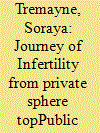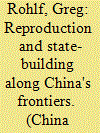| Srl | Item |
| 1 |
ID:
180470


|
|
|
|
|
| Summary/Abstract |
Long-term care (LTC) policies are urgently needed for required services, including workforce support and insurance planning. China has a large population and just recently entered an aging stage, whereas Taiwan is about to become a super-aged society. China and Taiwan have similar cultural context, sharing the same value of Chinese filial piety and living habits although they have distinct political systems. Results shows that there is no silver bullet that would solve the current shortage of an LTC workforce that would fill the gap between care recipients and licensed professionals or informal caregivers. It is clear that action is required in all the aspects of LTC reform. The Taiwan system is comparatively solid while China’s system is struggling despite well-planned policy making.
|
|
|
|
|
|
|
|
|
|
|
|
|
|
|
|
| 2 |
ID:
171092


|
|
|
|
|
| Summary/Abstract |
This study explores the process by which the treatment of infertility, which has been in the hands of the private sector, has been taken over by the state as a matter of public health. It argues that this shift stems from the pro-natalist policies of the state to help increase the population. Infertility treatment, using assisted reproductive technologies and its legitimization by the Islamic jurists, is used as a lens through which to examine the state's body politic. The frequent reversals of policies, since the late nineteenth century to the present, are shown to be directly linked with the nation-building goals of the state, expecting the citizens to readjust their reproductive behavior to meet the state’s policies.
|
|
|
|
|
|
|
|
|
|
|
|
|
|
|
|
| 3 |
ID:
079928


|
|
|
|
|
| Publication |
2007.
|
| Summary/Abstract |
This article analyzes population resettlement to western China during contemporary times within a historical framework that emphasizes gender. During the 1950s most relocatees to Qinghai were men, following the historical pattern set by Qing policies. Empirical data also show that the PRC government explicitly recruited women for relocation to border and remote areas. Women were moved to western regions as somewhat gender-neutral workers and also to serve in their traditional roles as wives and mothers. In both roles, women were a crucial component in state-building policies in border and remote areas. In fact, because sovereignty could not be permanently established without a naturally reproducing population, one can argue that reproduction was, and is, a basic component of state-building-an assertion that gets little attention in analyses of social and political change in border regions. This article describes the consolidation phase of territorial expansion as a feminine or yin process that relied upon incremental, organic growth, or "soft" assertions of power. Government documents, published materials, census records, and journalistic reporting are used to demonstrate these patterns and processes.
|
|
|
|
|
|
|
|
|
|
|
|
|
|
|
|